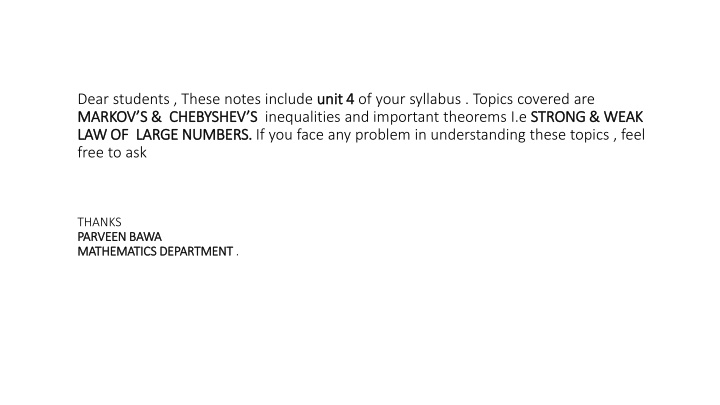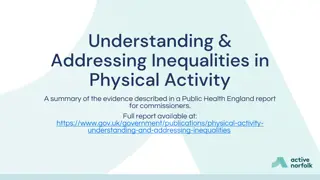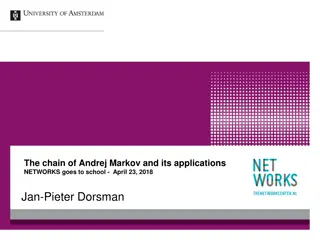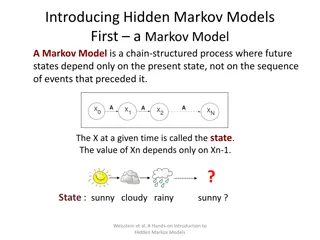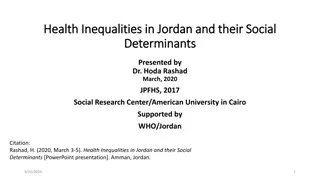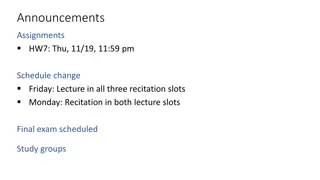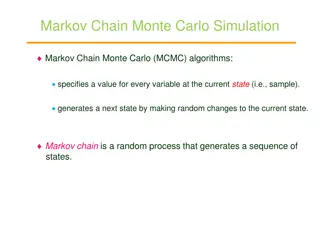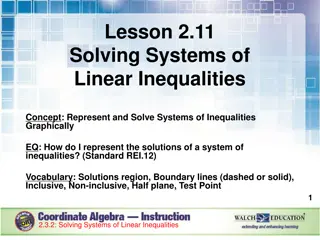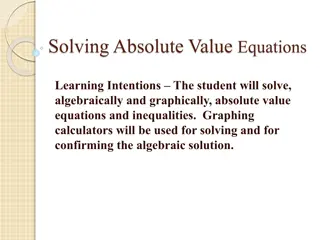Markov's & Chebyshev's Inequalities Overview
These notes cover the key theorems and inequalities in Unit 4 of the syllabus, including Markov's and Chebyshev's inequalities, as well as the Strong and Weak Law of Large Numbers. Explore how these concepts are applied in probability and statistics, with detailed proofs and explanations provided by Parveen Bawa from the Mathematics Department at Deshbandhu College, Kalkaji.
Download Presentation

Please find below an Image/Link to download the presentation.
The content on the website is provided AS IS for your information and personal use only. It may not be sold, licensed, or shared on other websites without obtaining consent from the author.If you encounter any issues during the download, it is possible that the publisher has removed the file from their server.
You are allowed to download the files provided on this website for personal or commercial use, subject to the condition that they are used lawfully. All files are the property of their respective owners.
The content on the website is provided AS IS for your information and personal use only. It may not be sold, licensed, or shared on other websites without obtaining consent from the author.
E N D
Presentation Transcript
Dear students , These notes include unit 4 MARKOV S & CHEBYSHEV S MARKOV S & CHEBYSHEV S inequalities and important theorems I.e STRONG & WEAK LAW OF LARGE NUMBERS. LAW OF LARGE NUMBERS. If you face any problem in understanding these topics , feel free to ask unit 4 of your syllabus . Topics covered are STRONG & WEAK THANKS PARVEEN BAWA PARVEEN BAWA MATHEMATICS DEPARTMENT MATHEMATICS DEPARTMENT .
DESHBANDHU COLLEGE, KALKAJI DESHBANDHU COLLEGE, KALKAJI MATHEMATICS DEPARTMENT MATHEMATICS DEPARTMENT PROBABILITY AND STATISTICS PROBABILITY AND STATISTICS By PARVEEN BAWA By PARVEEN BAWA Theorem 1 : MARKOV S INEQUALITY Let X be a random variable, which takes only non-negative values. Then P(X ?) ? ? ?? ? Proof: Let X be a continuous random variable with probability density f(?), ? 0 ?.?(?)?? E(X) = 0 ??(?)d?+ ? ?? ? ?? = 0 ?? ? ? ??(?) ??(?) ?? ? ? ? ???? ??(?) 0 0 ? ? ??, ?? ? ?? 0 ? ??? ? ?? + ? ?? ? d? 0 = ap(X ?) E(x) ?? ? ? 1 ?E(X) ?(? ?)
DESHBANDHU COLLEGE, KALKAJI DESHBANDHU COLLEGE, KALKAJI MATHEMATICS DEPARTMENT MATHEMATICS DEPARTMENT PROBABILITY AND STATISTICS PROBABILITY AND STATISTICS By PARVEEN BAWA By PARVEEN BAWA Theorem 2: CHEBYSHEV S INEQUALITY If X is a random variable with mean ? and variance ?2, then ?2 ?2, ? P(|x-?| ?) Proof P(|x-?| ?)= P(|? ?|2 ?2) =P(Y ?2), where y = |? ?|2 So y takes only non negative values, using Markov s inequality P(Y ?2) ?(?) ?2 P(|? ?|2 ?2) ?(|? ?|2) ?2 P(|x-?| ?) ???? ?2 ?2=?2
DESHBANDHU COLLEGE, KALKAJI DESHBANDHU COLLEGE, KALKAJI MATHEMATICS DEPARTMENT MATHEMATICS DEPARTMENT PROBABILITY AND STATISTICS PROBABILITY AND STATISTICS By PARVEEN BAWA By PARVEEN BAWA REMARK: if we replace k by k? ?? ? ???? ?? ? ??????????,we get P(|x-?| ??) ???? ?2?2= Also , if we write P(|x-?| ??)=1- P(|x-?|< ??) then, we get 1 ?2 ?2 ?2 ?2?2=1 (??)2= ?2 P(|x-?|< ??) 1 So, a restatement of Chebyshev s inequality becomes : ? ?? 2) P(|x-?| ??) ?? These markov s and Chebyshev s inequality are used to find bounds of probability 1) P(|x-?|< ??) ? ?
DESHBANDHU COLLEGE, KALKAJI DESHBANDHU COLLEGE, KALKAJI MATHEMATICS DEPARTMENT MATHEMATICS DEPARTMENT PROBABILITY AND STATISTICS PROBABILITY AND STATISTICS By PARVEEN BAWA By PARVEEN BAWA Questions based on markov s and Chebyshev s inequality Q1) use Chebyshev s theorem to find least value of k, such that the probability that X lies between ? ?? ??? ? + ?? is atleast 0.95. Solution: By Chebyshev s inequality, we have 1 P(|x-?|< ??) 1 ?2 1 ?(? ?? < ? < ? + ??) 1 ?2 So we have to choose k such that 1 ?2 0.95 0.05 ?2 ?2 5=20 k 20 1 1 0.05=100 1 So the least value of k is 20
DESHBANDHU COLLEGE, KALKAJI DESHBANDHU COLLEGE, KALKAJI MATHEMATICS DEPARTMENT MATHEMATICS DEPARTMENT PROBABILITY AND STATISTICS PROBABILITY AND STATISTICS By PARVEEN BAWA By PARVEEN BAWA Q2) If E(x)=3 and E(?2)=13, find a lower bound for P(-2<X<8)? Solution : Now in this que we have to find lower bound, so we will use chebyeshev s inequality of the type : 1 ?2 For this we need ?,? ??? ? Now ?=E(X)=3 ?2=E(?2)-(?(?))2=13-9=4 ? = 2 P(|x-?|< ??) 1 P(-2<X<8)=P(-2-3<X-3<8-3) =P(-5<X-3<5) by Chebyshev s inequality, we have 1 P(|x-?|< ??) 1 ?2 4 52=21 P(|x 3| < 5) 1 Hence the lower bound is 21 25 25
DESHBANDHU COLLEGE, KALKAJI DESHBANDHU COLLEGE, KALKAJI MATHEMATICS DEPARTMENT MATHEMATICS DEPARTMENT PROBABILITY AND STATISTICS PROBABILITY AND STATISTICS By PARVEEN BAWA By PARVEEN BAWA Q3) A random variable X takes the values -1,-1,3,5 with associated probabilities 1 2respectively. Find by direct computation P(|X-3| 1) Type equation here.. Find the upper bound to this probability by applying Chebyshev s inequality. 6, 1 6, 1 6and 1 Solution: First we will find probability by direct computation method. For this P(|X-3| 1)=1-P(|X-3| 1) =1-P(-1<X-3<1) =1-P(2<X<4) =1- P(X=3){as X takes only value 3 between 2 and 4 } =1-1 6 6=5
DESHBANDHU COLLEGE, KALKAJI DESHBANDHU COLLEGE, KALKAJI MATHEMATICS DEPARTMENT MATHEMATICS DEPARTMENT PROBABILITY AND STATISTICS PROBABILITY AND STATISTICS By PARVEEN BAWA By PARVEEN BAWA Now we will find probability by Chebyshev s inequality ?(|? ?| ?) <?2 ?2 For this we need ? and ?2 ?=E(X)=-1.1 E(?2)=43 3 ?2= E(?2)-(?(?))2= 43 Now by comparing Chebyshev s inequality and required probability, we get k=1 16 3 1= 16 So, the upper bound is 16 3 6+1 .1 ?? ???????? ??????? ?2.?(?) 3-9= 16 6+3 .1 6+5 .1 2= 1 2+ 5 2=3 3 So, P(|X-3| 1)< 3.
DESHBANDHU COLLEGE, KALKAJI DESHBANDHU COLLEGE, KALKAJI MATHEMATICS DEPARTMENT MATHEMATICS DEPARTMENT PROBABILITY AND STATISTICS PROBABILITY AND STATISTICS By PARVEEN BAWA By PARVEEN BAWA CENTRAL LIMIT THEOREM This theorem provides a simple method for computing approximate probabilities for sums of independent random variables Statement: let ?1,?2, ..??be independent and identically distributed random variables, each with mean ? and variance ?2.let ?1+?2+ ..+?? ? be their mean variable, then the distribution of ?? ? ? ? Proof To show that Z tends to standard normal as n , we will fimd M.G.F and prove that M.G.F of Z is same as that of standard normal Now ??(t)=E(???) tends to standard normal distribution as n Z= ?? ? ? ? ? =E ? ?? ? ? E(? ? ? ???) =?
DESHBANDHU COLLEGE, KALKAJI DESHBANDHU COLLEGE, KALKAJI MATHEMATICS DEPARTMENT MATHEMATICS DEPARTMENT PROBABILITY AND STATISTICS PROBABILITY AND STATISTICS By PARVEEN BAWA By PARVEEN BAWA ? ? ? (?1+?2+ ..+?? ? ? ?(?1+?2+ ..+??)) ? ? ??1) .. ?(? ? ? ?) . ???( But as all random variables are identically distributed , so all have same M.G.F ??1( ?? ? ? E(? ?? ? ? E(? ?? ? ? ?(? ?? ? ? =? )) ? =? ? = ? ? ???) ? = ? ??1( ? ?) ..(1) ? ? ? ?) = = ???( ? ?)=M(t) ?? ? ? (?(?))? (1) ? Taking log both sides, we get Log??(t)= ?? ? ? M(t)=E(???)=E(1+tx+(??)2 + ) +n Log M(t) 2
DESHBANDHU COLLEGE, KALKAJI DESHBANDHU COLLEGE, KALKAJI MATHEMATICS DEPARTMENT MATHEMATICS DEPARTMENT PROBABILITY AND STATISTICS PROBABILITY AND STATISTICS By PARVEEN BAWA By PARVEEN BAWA ?? ? ?+?2?2 +?? ? = ?? ? 2?+ +n ? ?+?2 = ?? ? 2+ . ? Putting n ,?? ??? log??(t) ?2 2 Which is M.G.F of normal distribution with mean 0 and variance 1, hence Z has the distribution of N(0,1)when n
DESHBANDHU COLLEGE, KALKAJI DESHBANDHU COLLEGE, KALKAJI MATHEMATICS DEPARTMENT MATHEMATICS DEPARTMENT PROBABILITY AND STATISTICS PROBABILITY AND STATISTICS By PARVEEN BAWA By PARVEEN BAWA Weak law of large numbers(W.L.L.N) Statement Let ?? be a sequence of random variables, such that E(??)=? , ???(??)=?2. For each n, let ??=Var(?1+ ?2+ ?3 . +??) and ?? ?2= 0, then given any > 0, and ? > 0,there exists ?0 lim ? ,??? ? ?? ?(|?? ?(??)| < ?) > 1 ? ? ?0 Proof we know that: ??=?1+?2+ ..+?? Var(??)=Var(?1+?2+ ..+?? , ? )= 1 ?2var(?1+ ?2+ ?3 . +??) = ?? ?2 ?
DESHBANDHU COLLEGE, KALKAJI DESHBANDHU COLLEGE, KALKAJI MATHEMATICS DEPARTMENT MATHEMATICS DEPARTMENT PROBABILITY AND STATISTICS PROBABILITY AND STATISTICS By PARVEEN BAWA By PARVEEN BAWA ? ?? Using Chebyshev s inequality P(|x-?|< ??) ? to the variable ??, we get P(|?? ?(??)| < ?) > 1 Var(??) ?? ?2?2 (1) ?2 =1- ?? ?2= 0 and lim ?? ?2?2=0 we are given that lim ? ? ????????????? ?? ? > 0, there exists ?0 , such that ?? ?2?2-0|< ? ? ?0 | ?? ?2?2< ? - ? < ? ?0
DESHBANDHU COLLEGE, KALKAJI DESHBANDHU COLLEGE, KALKAJI MATHEMATICS DEPARTMENT MATHEMATICS DEPARTMENT PROBABILITY AND STATISTICS PROBABILITY AND STATISTICS By PARVEEN BAWA By PARVEEN BAWA ?? ?2?2 - ? < ?? ?2?2 1 ? < 1 From (1), we get ?? ?2?2> 1 ? P(|?? ?(??)| < ?) > 1 ? ?0 INTERPRETATION OF W.L.L.N P(|?? ?(??)| < ?) > 1 ? ? ?0 .. (a) Also P(|?? ?(??)|) < ?) 1 . (?) Combining (a) and (b) P(|?? ?(??)|) < ?) 1 ?? ? i.e |?? ?(??)|) < ? ??????? ? ???? ????? ? ?? ? ?? ?????
DESHBANDHU COLLEGE, KALKAJI DESHBANDHU COLLEGE, KALKAJI MATHEMATICS DEPARTMENT MATHEMATICS DEPARTMENT PROBABILITY AND STATISTICS PROBABILITY AND STATISTICS By PARVEEN BAWA By PARVEEN BAWA STRONG LAW OF LARGE NUMBERS Let ?? be a sequence of random variables, such that E(??)=? ,???(??)=?2.let ??=?1+?2+ ..+?? ? 1 ?? ?=? Var(??)=1 ?2 ? ?2=?2 So all the conditions of W.L.L.N are satisfied it follows P(|?? ?(??)| < ?) = 1 ?, ?, however small n>?0 P(|?? ?(??)|) < ?) 1 Thus P(|?? ?(??)|) < ?) = 1 as n INTERPRETATION OF STRONG LAW OF LARGE NUMBERS It becomes almost certain that a sample mean tends to population mean, when large number of samples are taken from a population be their mean variables, then for each ? > 0 , P(|?? ?(??)| < ?) = ?2(Var(?1)+ .+Var(??))=??2 ?2=?2 ? ?? ?2= lim Now we have lim ?3=0 ? ?
